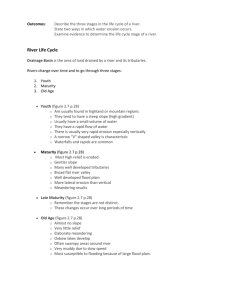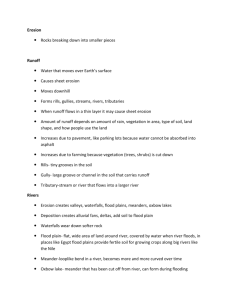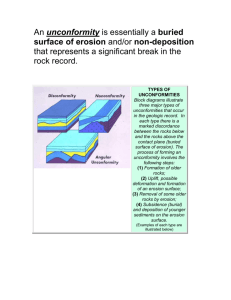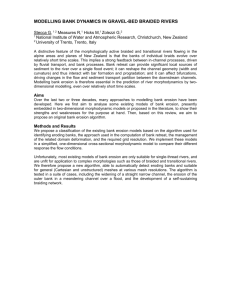Running Water
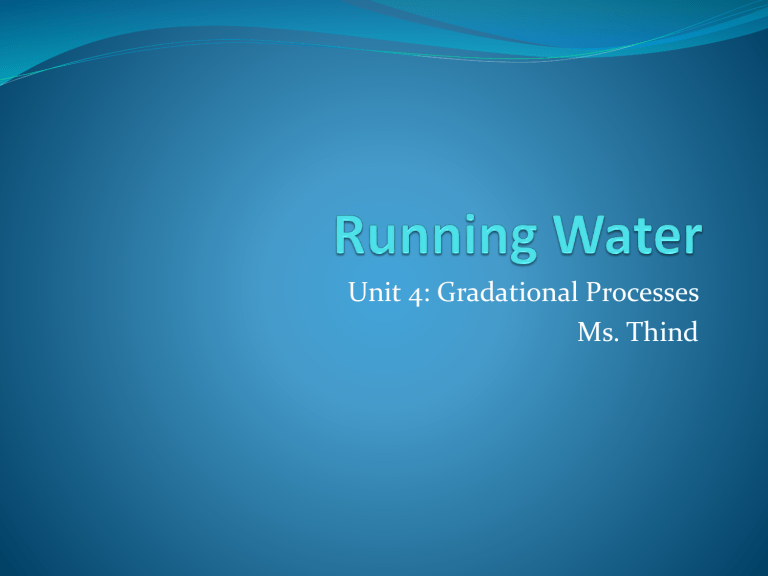
Unit 4: Gradational Processes
Ms. Thind
Running Water
Today we will:
Identify the processes associated with running water
AND
Identify the erosional and depositional features associated with running water
Drainage Patterns
As rivers erode the landscape a certain drainage pattern begins to take shape. A definite determining factor in the formation of a drainage pattern is the hardness of rock layers in a region.
Drainage Patterns
There are four main types of drainage patterns:
1. Dendritic
2. Trellis
3. Radial
Dendritic
Most common
Resembles the veins of a leaf
Pattern found in areas where rock layers are of uniform hardness
Trellis
In areas where folding and tilting of rock layers confine rivers to parallel valleys that meet a larger stream at right angles.
Radial
Occurs on cone-shaped mountains (volcanoes)
Water will flow away from the high point of equally in all directions
Typical Drainage Patterns
Note: Have a look at the landscape in which these drainage patterns occur and the direction of running water.
Name that drainage pattern:
Four stages of river development:
1.
Youth Stage:
cuts a deep V-shaped valley as fast moving water transports material downstream.
Rivers are dominated by erosion as turbulent water allows little deposition to occur.
Features: rapids, waterfalls, various boulders along river bed.
Four stages of river development
2. Mature Stage:
Definite drainage pattern evident in watershed.
Vertical erosion continues but downstream lateral erosion of banks is evident as meanders and flood
plain start to take shape.
Velocity of flow slows and deposition of river sediment is common.
Four stages of development
3. Old age stage:
Flood plain that developed in mature stage continues to widen and meanders widen.
River can cut across meanders to create oxbow lakes.
Natural levees develop along river banks as materials get deposited by flooding.
River delta is well developed and can continue to grow each year as sediment is flushed down from the highland regions.
Four stages of development
4. Rejuvenated stage:
Land has undergone a slow uplifting and the river has returned to a period of vertical erosion like the youthful stage and a deep v shaped valley takes shape.
River continues to cut through flood plain that was created in old age stage and continues vertical erosion until elevation is close to sea level again.
Once elevation has been reduced lateral and vertical erosion take place = new flood plain.
Erosion action by rivers
Hydraulic action:
Force of water has great power.
Material is worked loose from banks and river bed then carried downstream and deposited in lower regions where water flow diminishes.
Greater the velocity the greater the erosion
Erosion action by rivers
Abrasion:
Debris and sand have an abrasive effect on river banks and river beds.
Rocks look polished by the abrasive power of the river’s load.
Attrition:
When water moves fast, rocks of varying sizes are moved along by the river and they repeatedly strike other rocks breakup of rock into smaller pieces.
Erosion action by rivers
Corrosion:
Rivers are mildly acidic and some rocks are dissolved in water and transported.
Transporting Sediment:
1) Solution:
2) Suspension:
3) Saltation:
4) Traction:
Unit 4: Gradational Processes
Ms. Thind
Let’s Review…
1) Identify the form of erosion where rocks repeatedly strike other rocks.
2) This form of erosion dissolves rock and is transported by the river.
3) This feature includes the building of alluvium deposits.
4) _______________ is when very heavy rocks drag along the river bottom.
5) Identify the process of rocks bouncing and rolling off other rocks along river bottom.
River Landforms
Waterfalls
Rapids
Flood plains
Levees
Meanders
Oxbow Lakes
Undercut/point bar
Today we look at…
Potholes
Gorges/Canyons
River Terraces
Braided Rivers
Sand bars
Deltas
Pothole
A deep abraded hole in a riverbed created by pebbles caught in a circulating hole.
How potholes are formed
Regions with volcanic origin have many waterfalls that cascade over igneous rock of varying
hardness.
As water moves along, a pothole may form along a river bed where pebbles can become trapped in a small depression.
Power of water spins these pebbles around and
abrasive action deepens the hole.
Gorges/Canyons
When vertical erosion is rapidly occurring, a river may form a deep, narrow slot through the landscape known as a gorge or canyon.
River Terraces
Uplifting of land occurs a river must again begin vertical erosion and a gorge is cut through the original flood plain.
The old uplifted flood plain is known as a terrace.
Braided Rivers
Some rivers take on a braided appearance with many sand and gravel
islands splitting up the water flow braided rivers.
They transport large volumes of debris and deposit it along the river channel to create sand
bars and islands.
River Deltas
A river carries sediment from its drainage basin toward the sea and much of it is deposited on the flood plain when the stream slows down. The
deposits form river deltas.
There are 3 main types of deltas: arcuate, bird’s foot, and estuarine.
Arcuate delta
Has many distributaries that carry water and sediment across a symmetrical delta
Shape of an inverted cone
Bird’s food delta
Has many distributary channels that branch out from the main river channel
Bird’s foot appearance
Estuarine delta
Forms when river sediment is deposited in a submerged river mouth.
Grows in shape of estuary.
1.
2.
3.
4.
5.
6.
Erosional or Depositional
Landform?
V Shaped Valley
Waterfall
Levees
Delta
Gorge
Sandbars

